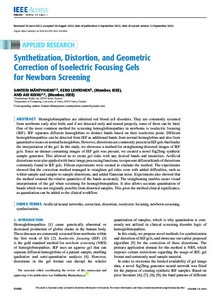Synthetization, Distortion, and Geometric Correction of Isoelectric Focusing Gels for Newborn Screening
Mäntyniemi Santeri; Lehtonen Eero; Koivu Aki
https://urn.fi/URN:NBN:fi-fe2022102462994
Tiivistelmä
Hemoglobinopathies are inherited red blood cell disorders. They are commonly screened from newborns early after birth, and if not detected early and treated properly, some of them can be fatal. One of the most common method for screening hemoglobinopathies in newborns is isoelectric focusing (IEF). IEF separates different hemoglobins to distinct bands based on their isoelectric point. Different hemoglobinopathies can be detected from IEF as additional bands from normal hemoglobins and also from quantitative issues in normal hemoglobins. However, distortions are commonly present in IEF gels that hinder the interpretation of the gel. In this study, we showcase a method for straightening distorted images of IEF gels. Since no dataset containing images of IEF gels was present, we created a novel Sig2Img synthetic sample generator. This allowed us to create gel sides with any desired bands and intensities. Artificial distortions were also applied with basic image processing functions, to represent different kinds of distortions commonly found in IEF gels. Fifteen experiments were created to evaluate the method. The experiments showed that the correction method managed to straighten gel sides even with added difficulties, such as within-sample and sample-to-sample distortions, and added Gaussian noise. Experiments also showed that the method retained the relative quantities of the bands accurately. The straightening enables easier visual interpretation of the gel when screening for hemoglobinopathies. It also allows accurate quantitation of bands which was not originally possible from distorted samples. This gives the method clinical significance, as quantitation can be added to the clinical workflow.
Kokoelmat
- Rinnakkaistallenteet [27094]
